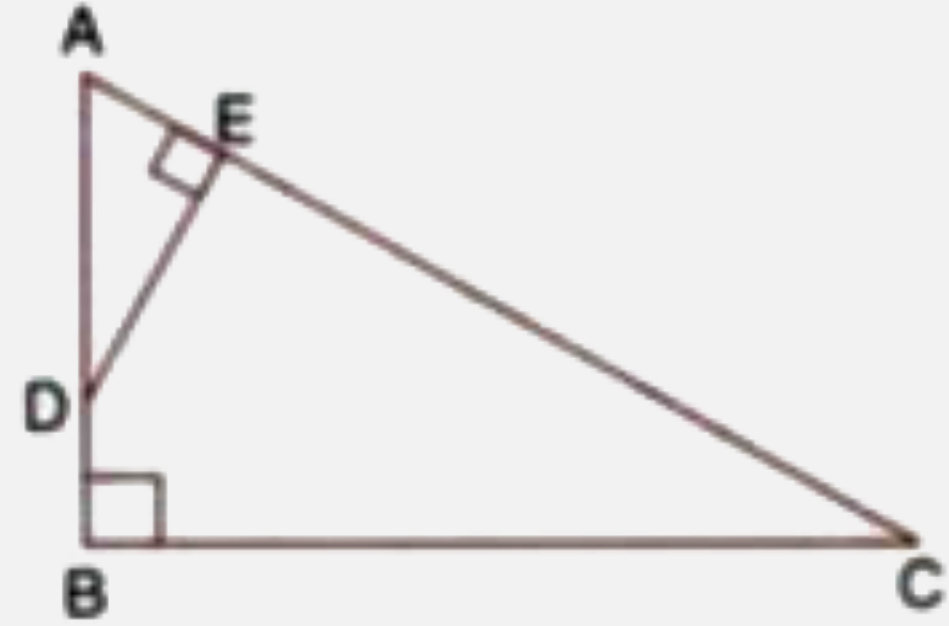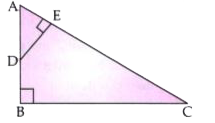ABC is a right triangle right-angled at B. Let D and E be any points on AB and BC respectively. Prove that AE2+CD2=AC2+DE2
To prove that AE2+CD2=AC2+DE2 in triangle ABC which is right-angled at B, we will follow these steps:
Step 1: Identify the Right Triangles
Since triangle ABC is right-angled at B, we can identify two smaller right triangles:
- Triangle ABE (right-angled at B)
- Triangle BDC (right-angled at B)
Step 2: Apply the Pythagorean Theorem to Triangle ABE
For triangle ABE:
AE2=AB2+BE2(1)
Step 3: Apply the Pythagorean Theorem to Triangle BDC
For triangle BDC:
CD2=BD2+BC2(2)
Step 4: Add Equations (1) and (2)
Now, we add the two equations:
AE2+CD2=(AB2+BE2)+(BD2+BC2)
This simplifies to:
AE2+CD2=AB2+BE2+BD2+BC2(3)
Step 5: Apply the Pythagorean Theorem to Triangle ABC
For triangle ABC:
AC2=AB2+BC2(4)
Step 6: Apply the Pythagorean Theorem to Triangle BDE
For triangle BDE:
DE2=BD2+BE2(5)
Step 7: Substitute Equations (4) and (5) into Equation (3)
From equation (4), we know AB2+BC2=AC2.
From equation (5), we know BD2+BE2=DE2.
Substituting these into equation (3):
AE2+CD2=AC2+DE2
Conclusion
Thus, we have proved that:
AE2+CD2=AC2+DE2
Since triangle ABC is right-angled at B, we can identify two smaller right triangles:
- Triangle ABE (right-angled at B)
- Triangle BDC (right-angled at B)
For triangle ABE:
AE2=AB2+BE2(1)
For triangle BDC:
CD2=BD2+BC2(2)
Now, we add the two equations:
AE2+CD2=(AB2+BE2)+(BD2+BC2)
This simplifies to:
AE2+CD2=AB2+BE2+BD2+BC2(3)
For triangle ABC:
AC2=AB2+BC2(4)
For triangle BDE:
DE2=BD2+BE2(5)
From equation (4), we know AB2+BC2=AC2.
From equation (5), we know BD2+BE2=DE2.
Substituting these into equation (3):
AE2+CD2=AC2+DE2
Thus, we have proved that:
AE2+CD2=AC2+DE2
Topper's Solved these Questions
Similar Questions
In Figure, ABC is a right triangle right angled at B and points DandE trisect BC . Prove that 8AE2=3AC2+5AD2.
View SolutionIn Fig. 3, ABC is a right triangle, right angled at C and D is the mid-point of BC. Prove that AB2=4AD2−3AC2.
View SolutionABC is a triangle right angled at C. If AB=25cmandAC=7cm, find BC.
View SolutionABC is a right angled triangle with ABC=90∘. D is any point on AB and DE is perpendicular to AC. Prove that:

If AC = 13 cm, BC = 5 cm and AE = 4 cm. Find DE and AD.
View SolutionABC is a right triangle right angled at A. BCED, ACFG and ABMN aresquares on the sides BC, CA and AB respectively. Line segment AX⊥DEmeets BCat Y. Show that:(i) ΔMBC≅ΔABD(ii) a r\ (B Y X D)\ =\ 2\
View SolutionABC is a right angled triangle with ABC=90∘. D is any point on AB and DE is perpendicular to AC. Prove that:

ΔADE~ΔACB.
View SolutionABC is a right angled triangle with ABC=90∘. D is any point on AB and DE is perpendicular to AC. Prove that:

Find, area of AADE: area of quadrilateral BCED.
View SolutionΔABD is a right triangle, right-angled at A and AC⊥BD. Prove that AB2=BC×BD.
View SolutionABC is a right angled triangle with ∠ABC=90∘, D is any point on AB and DE is perpendicular to AC. Prove that :

(i) ΔADE~ΔACB.
View SolutionΔABC is a right triangle right angled at A such that AB=AC and bisector of ∠C intersects the side AB at D. Prove that AC+AD=BC.
View Solution
